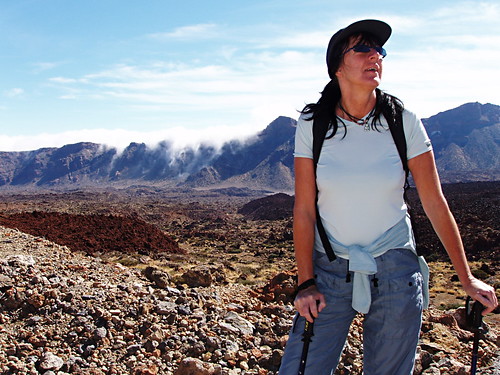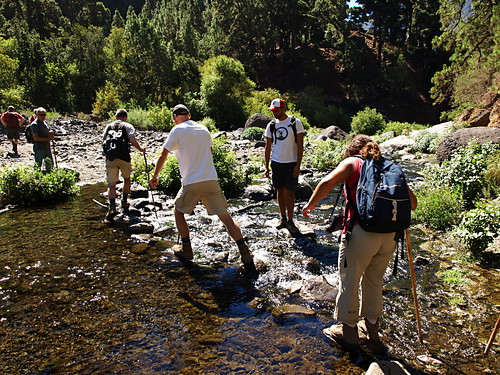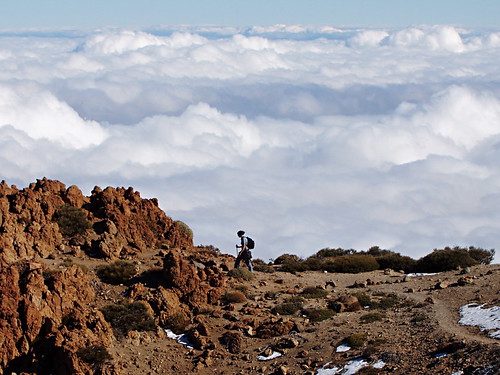Walking Mam Tor Ridge in the Peak District one icy Boxing Day many years ago, Jack slipped and began to fall towards the road below. Luckily, his walking pole caught between two large boulders, leaving Jack lying face down in the snow, one arm outstretched gripping the pole, and Sarah and I in helpless laughter. Clearly, it wasn’t funny as Jack would most likely have broken an ankle or leg at best and been hit by a car and killed at worst. Perhaps it was the relief that caused the hysteria. Whatever it was, there’s no doubt that having a walking pole that day proved to be very useful indeed.
Since launching our Tenerife Island Walks self guided route notes, Jack and I have abandoned our walking poles for the simple reason that they get in the way. When we’re out walking we’re always taking or checking notes; using voice memos; noting timings, GPS readings and distances, and taking photographs. Trying to juggle a notebook and pen, GPS, iPhone, camera, map and written notes while traversing caminos reales is enough of a nightmare without having a couple of poles hanging off wrist straps and creating mayhem into the bargain.
Having notched hundreds (maybe even thousands, who knows?) of kilometres on foot, we’re pretty well versed on the pros and cons of life on the trail, with and without the support of walking poles. If you’re planning a walking holiday to Tenerife or to any of the Canary Islands and are wondering whether walking poles are essential, here are a few of the things we’ve learned over the years to help you make an informed choice.
The advantages
The main advantage to using walking poles when walking in the Canary Islands is that they help to take the strain on those steep ascents and descents and whichever island you choose to walk on, you’re guaranteed to have a lot of ups and downs.
Choosing walking poles that have shock absorption is essential if you want to get most benefit from them when walking in the Canary Islands. They’re more expensive but the difference in price is an investment your knees will thank you for. Walking La Gomera, undoubtedly the most popular island for hikers, it’s impossible to walk anywhere without experiencing steep ascents and descents, mainly on cobbled caminos reales (old merchant trails). The wear and tear on knee joints can be gruelling on a 16km or 20km hike and using walking poles to absorb some of that shock is a definite advantage.
The most challenging walk on Tenerife in terms of stamina is probably the ascent of Mount Teide from Montaña Blanca. The trail itself is not difficult, we’re not talking crampons here except during the depths of winter, but the ascent is relentless and at an altitude of 2500 metres and above, the air is thin. The first time I climbed Mount Teide, okay the ONLY time I climbed Mount Teide, I was using my walking pole to quite literally drag myself the last few hundred metres to Alta Vista Refuge and then to the summit for our dawn ascent.
The disadvantages
One of the things that always annoyed me when I use walking poles was their inherent ability to get in the way whenever they weren’t actually in use. Every time I wanted to blow my nose or unzip my fleece, flying walking poles became missiles and Jack learned to stand well clear. Another trick my walking poles used to enjoy playing on me endlessly was to get themselves lassoed by trailing brambles or stuck into crevices in the rocks, suddenly wrenching my arm backwards.
But the biggest disadvantage to me is that people can become dependant on poles for their balance which makes their natural balance lazy.
Hiking La Caldera de Taburiente on La Palma, the group had to traverse a stream endlessly as we made our way down the floor of the caldera. At the start of the trail, the guide had distributed wooden walking staffs to all who wanted them. Everyone except the guide and Jack and I took one. When it came to our first traverse of the river, people used their stick to try to get an anchor on the river bed to help them to move from boulder to boulder. Almost everyone wobbled, wavered and got wet feet, except Jack and I who used our natural balance to traverse quickly and easily.
The question is, would I now use walking sticks again if I didn’t have to juggle an office when out hiking? I think the answer is probably not at the moment, but then I spend a great deal of my life walking up and down steep cliffs, mountains and barrancos and I know where and how to place my feet. If you can’t say the same, you should seriously consider giving some walking poles suitcase room.
How to use walking poles
It might sound elementary. I mean, how hard can it be to hold a stick when you’re walking? But if you’ve never used walking poles before, these few simple pointers will help. It’s also a good idea to get used to walking with them before you set off on your first big walk in the Canaries so get some practice in at home so you feel comfortable on the trail.
- Adjust the length of your poles so that when you’re standing on the flat your forearms are parallel to the ground. This will be your default setting for walking on the flat and you might want to mark the pole so it’s easy to get back to every time.
- When going uphill, shorten the poles a little, and when you’re going downhill, lengthen them a little.
- Push your hand into the strap from underneath it to grip the handle, not from above.









Where can I buy poles? We are going to be based in La Orotava.
Thanks
During the walking season you should be able to pick up cheap poles at the the Al Campo supermarket in the La Villa shopping centre in La Orotava. It’s a short drive from the town centre.
Can we buy or hire walking poles in Los Cristianos at all?
We bought most of our hiking gear from decathlon in La Laguna, but there are plenty of places around the island where you can buy poles. I’m not so sure about in the southern resort areas though. There are a couple of sport shops in Los Cristianos worth trying, like Intersport.